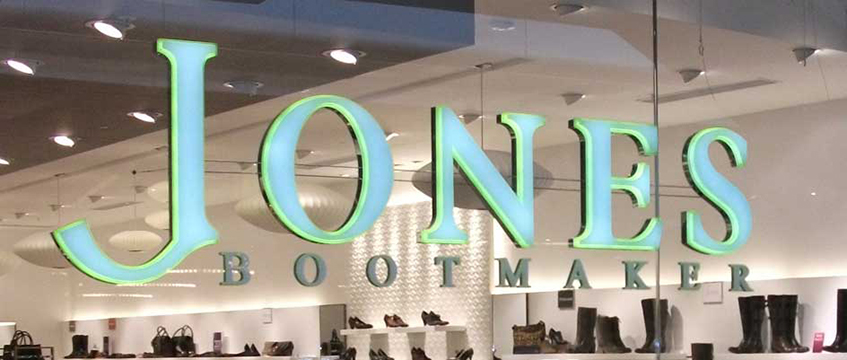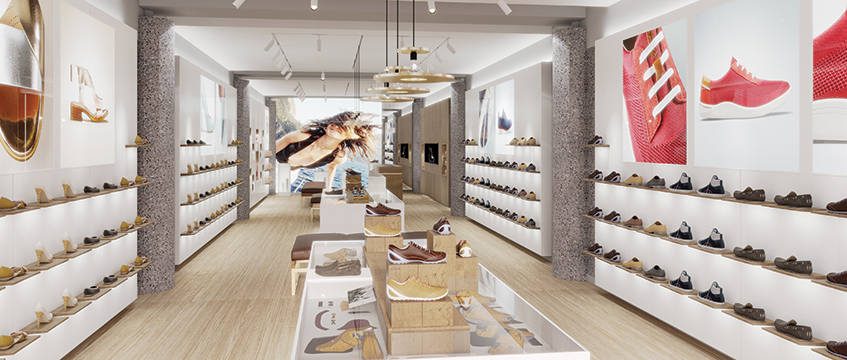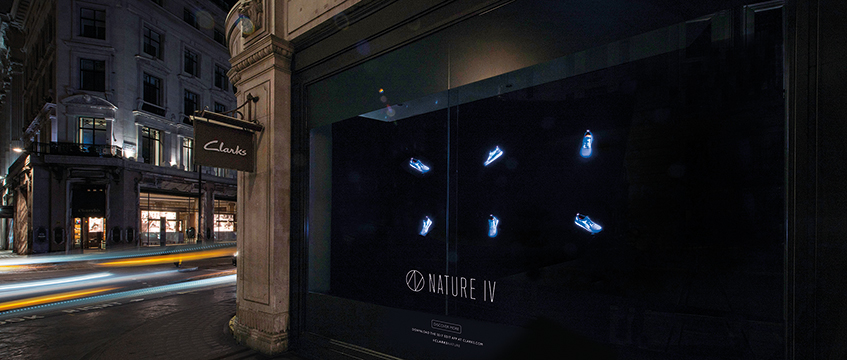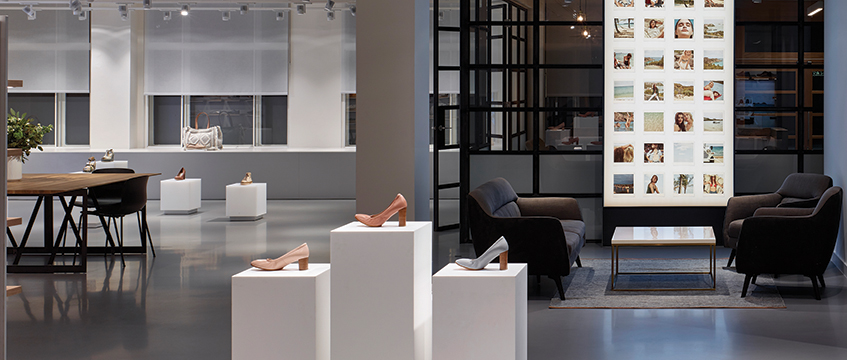Like a well-worn pair of favourite shoes that have started letting in water, part of the UK’s footwear retail sector is starting to look like it needs repairs – or even replacing.
A sharp decline in the value of sterling, the increase in business rates and changing consumer habits have created a challenging terrain.
The start of this year has seen high-profile administration hearings for high street brands Jones Bootmaker and Brantano. Jones Bootmaker was bought in an £11m rescue deal by UK private equity firm Endless, but Brantano has not found a buyer. Its 65 leases are now up for grabs, with administrator PwC working with GVA to find bidders. At the time EG went to press no deals had been made.
As the retail sector is evolving at a rapid pace, are high street footwear shops struggling to keep up?
One of the first signs of trouble is when retailers become cautious about taking new space. Shoe shops have become increasingly picky about deals over the past few years, according to market sources.
EG shopping centre and retail park data shows that Brantano has only opened four shops in the past three years. Successful competitors, although still behaving cautiously, have taken more space with Office, Schuh and Shoe Zone all taking more than 10 shops.
The data shows Jones Bootmaker being similarly inactive in terms of acquisitions, taking just three shops in this period.
| Store | Number of stores | Count of size | Sum of size (sq m) | Average sq m | Average sq ft | New stores taken since 2014 |
|---|---|---|---|---|---|---|
| Aldo | 22 | 8 | 1,661 | 207.59 | 2,234 | – |
| Clarks | 265 | 130 | 46,952 | 361.17 | 3,886 | 13 |
| Deichmann Shoes | 66 | 44 | 22,662 | 515.05 | 5,542 | 10 |
| Dune | 28 | 11 | 2,169 | 197.15 | 2,121 | – |
| Jones Bootmaker | 22 | 12 | 1,862 | 155.20 | 1,670 | 3 |
| Kurt Geiger | 38 | 18 | 3,020 | 167.78 | 1,805 | 2 |
| Office | 70 | 46 | 13,048 | 283.66 | 3,052 | 11 |
| Schuh | 87 | 58 | 20,692 | 356.77 | 3,839 | 13 |
| Shoe Zone | 170 | 64 | 13,841 | 216.26 | 2,327 | 11 |
| Brantano | 79 | 71 | 45,157 | 636.01 | 6,844 | 4 |
| Grand Total | 847 | 462 | – | – | – | 67 |
Source: EG research
Additionally, a number of footwear retailers are reviewing their estates for store performance, location and value. Clarks has appointed Harper Dennis Hobbs to review its portfolio.
Will there be store closures? Possibly. An insolvency expert who has worked with shoe retailers said that most shoe shops have too many units in their portfolios and closing down shops is the most commercially viable option to save money. However, many will try and avoid it so as not to send out the wrong message about their business.
The reality is that operating from a smaller estate would be beneficial for most shoe shops while they boost their online performance and ecommerce operations.
With the rise in online shopping and a growing customer preference for experience-driven retail, many retailers are reconsidering their options, with a gradual trend for fewer, but bigger and better, stores emerging.
Charlotte Peace, analyst at GlobalData Retail, says: “Many retailers are being too cautious about rationalising their store portfolios but can still achieve UK coverage through a smaller portfolio. We forecast the footwear market to have slow growth, particularly over the next three years, driven by online spend, so retailers must identify weaker stores and close these.”
In a similar vein to the fashion world, it is the value footwear sector which is feeling the most pressure.
“The lower end of the market is the most saturated space and when you are up against increasing price pressures it puts you in a very difficult position,” says Paul Langston, consulting partner, CACI.
The value footwear sector is also facing increasing competition from high street fashion retailers, which have diverse footwear lines of their own. When shops like New Look, H&M and Primark all stock a broad range of shoes, for some it eliminates the need to visit a shoe shop all together. With shopping habits leaning towards consumer convenience, with a customer preference to do all their shopping in one place, this problem is only likely to be exacerbated.
Peace adds: “We expect sportswear specialists such as Sports Direct and JD Sports to continue performing well and their market shares are forecast as 7.7% and 7.0% of the market respectively.
“Sportswear specialists will grow their share of the market along with clothing specialists, stealing sales away from footwear specialists.”
The evolving in-store experience
“You need a compelling reason to go to a footwear retailer,” says Langston. This is something that Clarks has started doing by re-furbishing its shop in Regent Street and its Russell Square showrooms – something which it plans to replicate across its portfolio.
One challenge shoe shops have, which is not felt elsewhere on the high street, is its reliance on staff to get shoes from the stock rooms. As well as being more expensive, it harder for the retailers evolve.
Tony Devlin, executive director, retail advisory and transaction services, CBRE, says: “Shoe shops have more staff per sq ft than nearly all others. You need to be personally attended to try on a pair of shoes, therefore the increase in living wage has a greater impact on shoe retailers than other fashion and apparel operators. There is a huge conundrum for shoe retailers over reducing staff against the impact on customer service.”
With the rise in ecommerce, shoe shops should make better use of in-store technology and the experiential aspect of retail to make their physical stores destinations to visit in their own right.
Peace adds: “Retailers such as Schuh have continued to innovate and have improved the customer experience by giving staff instore technology to check availability of stock, meaning staff don’t have to search around in stockrooms to find out whether a product is available. There are also a number of relatively new players in the market such as Public Desire and Shoeaholics which don’t have a store presence; these provide value trend-led footwear online and will likely perform well over the next few years.”
The occupier’s view: Mark Shearwood, chief executive, Clarks

“Our core focus is on giving our customers the best possible experience, which means enhanced service levels, availability, multi-channel alignment and in-store service.
This is an incredibly important focus for Clarks in common with our competitors. As a key brand on many of the UK’s high streets, we are committed to retaining our presence and making our business fit for the future in a world where consumers use multiple ways to choose and buy products. We have relaunched our European ecommerce platform and others will follow, and we are developing our digital strategy to enhance our consumer experience and to drive performance across key areas of our business.
We plan to expand our social media activity across the globe to better engage our consumers across the world with our brand, and are looking at how we can build social commerce into this also.
We are also planning a full review and modernisation of the company’s property portfolio. This will ensure that all stores are the right size, located in the right locations to enable us to provide the right offering that matches our status as a desired retailer on the high street.
This will be a big task but we are excited and looking forward to sharing our plans with landlords and working in partnership with them to explain the value that the Clarks brand can bring to their locations across the country.”
This article was first published on 30 March 2017
RETAIL & LEISURE SPECIAL
■ Brexit better than the 2008 recession… and the rise of the robots
Even in times of economic downturn, consumers still need to feed, wash and clothe themselves and so will continue to purchase items they require, less what they simply desire, meaning the convenience market, that in which NewRiver focuses on, will remain robust. Read more…
■ Discount chain applications power supermarket surge nationwide
Applications for new supermarkets grew 24% by square footage in 2016, with discount chains Aldi and Lidl dominating activity nationwide. Read more…
■ How to turn a profit from retail investment
An unusual deal closed in Ipswich this February – a deal that defied a trend plaguing retail landlords across the country. Read more…
■ Buying strategies of three UK shopping centre investors
“I’m wondering what a lot of investment agents are doing at the moment,” says Sovereign Centros chief executive Chris Geaves while pondering the question of how many shopping centres might change hands in 2017. Read more…
■ The new shape of retail and leisure development
Online retail, rising costs, viability issues and a discerning consumer that increasingly wants more from their shopping trip. It’s a heady mix that is piling pressure onto shopping centre developers. Against this backdrop, what are the prospects for the sector and its ability to deliver new space? Read more…
■ Crown Estate looks to its regional assets for growth prospects
This summer, the £140m Rushden Lakes retail and leisure scheme opens in Northamptonshire. For the Crown Estate – best known for its Regent Street, St James and Mayfair portfolio – the Northamptonshire project marks a new commitment to the regions. Its ambition is nothing less than to lead the regional retail market. Read more…
■ Why the UK’s thirst for coffee is good news for landlords and investors
Things have come a long way since Rowan Atkinson’s Blackadder III described the beverages served in Mrs Miggins’ London coffee shop as “brown grit in hot water”. Read more…
■ E-tail gets physical when building a brand
“We have enjoyed a lot of success online, but nothing beats the feeling you get standing outside your own store watching excited customers walk out clutching their bags,” says James Gold, co-founder of fashion accessories brand Skinnydip. Read more…
■ Can high street shoe shops step up as shopping habits shift?
Like a well-worn pair of favourite shoes that have started letting in water, part of the UK’s footwear retail sector is starting to look like it needs repairs – or even replacing. Read more…














